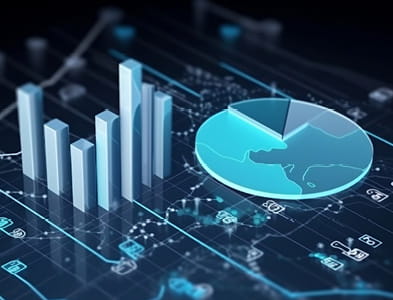Transformation and Technology Evolving Trends in Portfolio Valuation and Monitoring for Alternative Funds
Transformation and Technology Evolving Trends in Portfolio Valuation and Monitoring for Alternative Funds
As the alternative funds space has grown over the past 20 years, much has changed pertaining to the valuation and monitoring of portfolio investments, highlighting the need for adaptation and innovation.
Evolution of Portfolio Valuation
The development of formal standards in portfolio valuation and the growing reliance on third-party assistance has reshaped the landscape of alternative asset investments.
Development of Formal Standards
Financial Accounting Standard (FAS) 157 was introduced in 2006, clarifying existing rules around the use of fair value in measuring the values of portfolio investments for financial reporting purposes. In 2008, FAS 157 was reskinned as Accounting Standards Codification (ASC) 820. The International Accounting Standards Board introduced International Financial Reporting Standards 9 in 2009 to better align international fair value accounting standards with ASC 820, making fair value reporting a global standard for investors in alternative assets.
Growth in Use of Third Parties
With KKR’s public launch on the Euronext exchange, the use of third parties to assist and inject a level of independence in the valuation of fund assets was highlighted to the alternative asset community. The use of a third party to assist with a fund’s valuation process was so rare as to be difficult to call it an industry best practice. Fast forward to 2023, and the use of a third party to assist with a valuation process has been firmly established as a best practice, although a best practice that has not been universally adopted.
Portfolio Company Monitoring
As valuation best practices have evolved, so has the monitoring of portfolio companies. While the personal touch of deal teams speaking directly with portfolio company management will never go out of style, growing portfolios and an increasing thirst for data have placed increasing demands on both portfolio companies and private funds to gather, report, and analyze/interpret reported data.
In the “old days,” when portfolio company monitoring was primarily done by deal teams, job titles including “Portfolio Monitoring” did not exist. Today, funds’ back offices are taking on more responsibility to gather and monitor portfolio companies. Given that portfolio company data is a regular input to the valuation process, the internal valuation team finds itself on the front lines of portfolio monitoring. Additionally, dedicated portfolio monitoring teams are being formed.
Technology in Portfolio Valuation and Monitoring
Technology is front and center in portfolio valuation and portfolio monitoring, including the development of new platforms, models, and AI tools.
Monitoring Platforms
In 2011, Blackstone spun out its internal portfolio company monitoring platform (iLevel), which has spawned multiple competitors over the years – both dedicated (Chronograph) and as incremental functionality (eFront, Dynamo, etc.).
Valuation Models
Similarly, firms are looking to leverage technology in the valuation process. Many of the technology firms noted above have incorporated valuation models into their platforms. Companies have also launched standalone valuation model platforms (e.g., 73 Strings), and third-party valuation providers – including Stout - are increasingly leveraging technology to enhance their own valuation processes.
Artificial Intelligence
Additionally, AI tools such as ChatGPT have shown us that technology is advancing quickly and unpredictably. This will impact private funds’ portfolio monitoring and valuation processes, though the degree and speed of such change is currently unclear.
How To Prepare
Transitioning from manual valuation and portfolio monitoring processes to a more automated and efficient process can seem like a daunting task. Regardless of where your firm is on a maturity continuum, a good place to start is with an assessment of your current state processes (including people and technology), a clear depiction of where you’d like to go in the future (both the mid-term and long-term) and a high-level plan of how to get from your current state to the desired future state.
Even if a large-scale project is not possible in the near term, this program can be applied to find quick hits and automate smaller, repetitive tasks that will free up time and resources to focus on a large-scale implementation.
An illustrative program is shown below.
- Project Governance: Identify one project owner with the appropriate authority and key stakeholders from each of the cross-functional working groups. Define roles and responsibilities and a general timetable. Stakeholders should hold working sessions to build out a project plan for the program.
- Rapid Assessment of Current State: Hold working sessions to understand the current process, including the specific people and technologies used. Pay special attention to where handoffs occur (e.g., between departments, applications, or internal/external parties).
- Mid-Term and Future-State Design: Key stakeholders should document what a desired future-state process would look like. This should include IT systems, data flows, and responsible departments or groups.
- Gap Assessment: Compare the current state to the desired future state and make a list of all gaps. Cross-functional teams should be involved to identify any impacts to their processes.
- High-Level Road Map: Using the gaps identified in the preceding step, the project team should determine the necessary steps to close the gaps, including noting any areas that require additional, detailed assessment. These actions should be rated by priority and difficulty (e.g., considering time required, resource constraints, budgeting concerns, and dependencies) and should be time boxed.
Third-Party Assistance
The evolution of portfolio valuation and monitoring in the alternative funds space over the past two decades has highlighted the role of third-party experts in ensuring accuracy and efficiency. Third-party providers can guide organizations through this transition, offering insights into what other funds are doing while adding their expertise and technology to highlight what is possible to bridge gaps and streamline processes. As the industry continues to adapt and innovate, third parties remain essential in ensuring accurate portfolio valuation and monitoring, benefiting asset managers and investors alike.







